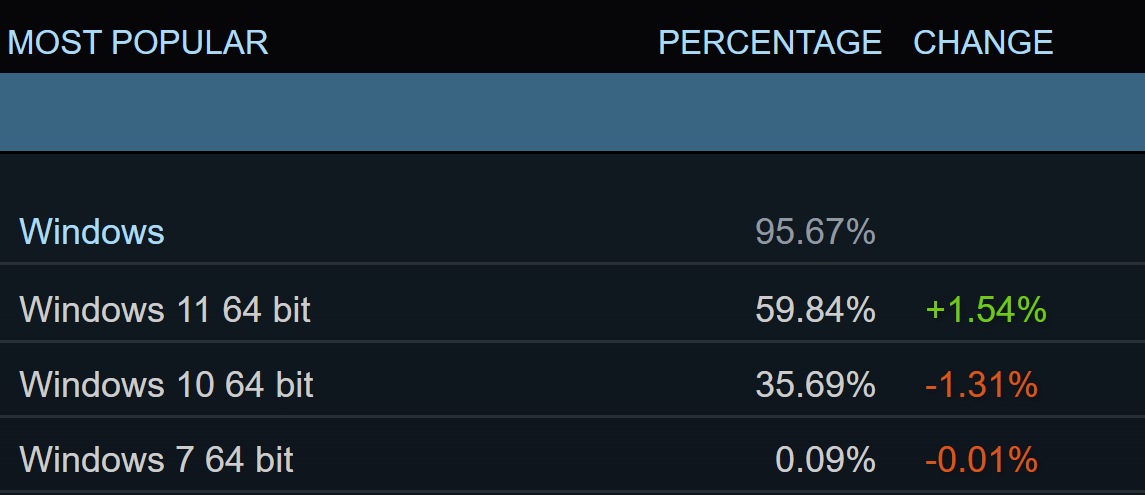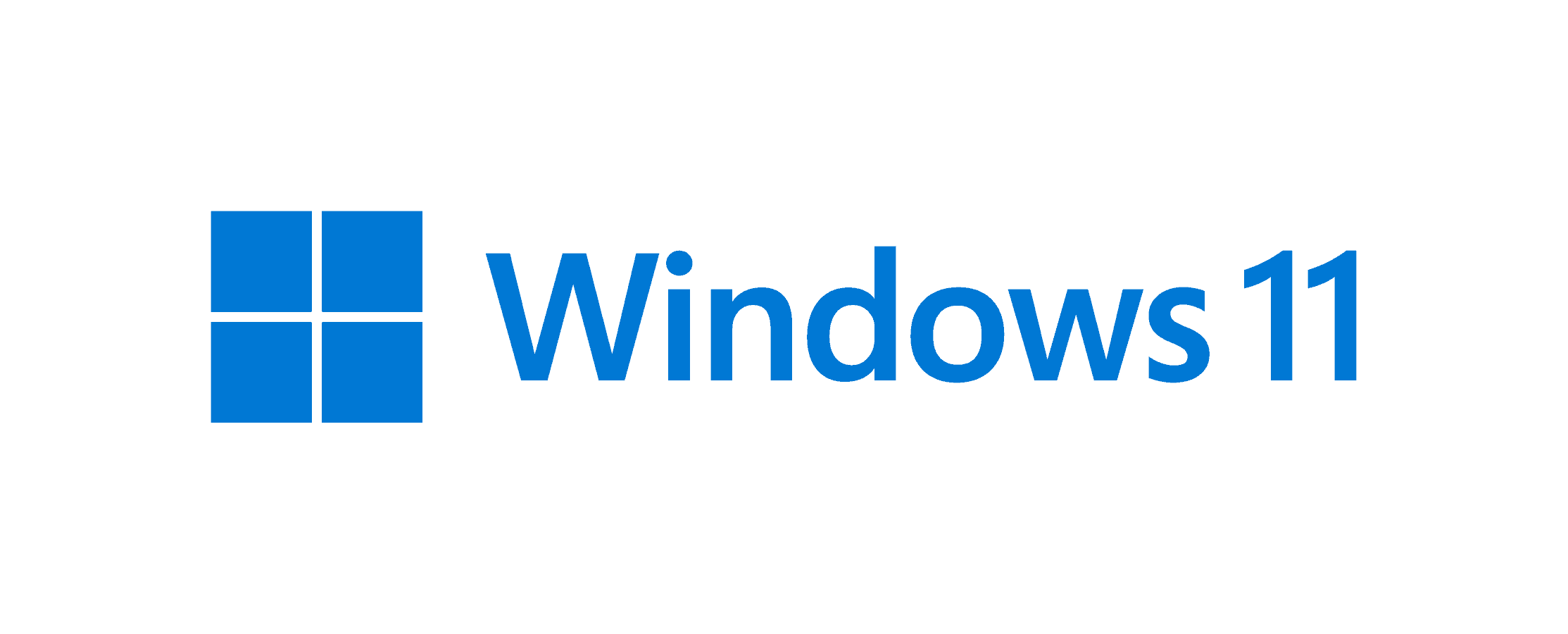Windows 10’s long reign over the PC gaming world is finally coming to an end. According to Valve’s newly released June 2025 Steam Hardware & Software Survey, Windows 11 now powers 59.84% of all active gaming systems on the platform, officially surpassing the combined share of all older Windows versions—including Windows 10, which has dropped to just 35.69%.
The numbers confirm what industry watchers have been predicting for over a year: Steam users are migrating away from Windows 10 en masse, spurred by hardware trends, software compatibility, and Microsoft’s looming end-of-support deadline.

The Turning Point for Windows 11
This isn’t just a symbolic milestone. In less than four years since its release, Windows 11 has overtaken its predecessor and become the de facto gaming OS on the most data-rich PC platform in the world. What makes this more impressive is how quickly that momentum has built. At the start of 2024, Windows 11 was still trailing Windows 10 by a wide margin.
But things changed fast. Microsoft aggressively pushed adoption through OEM deals, automatic upgrade offers, and exclusive features. Game developers began optimizing for Windows 11’s capabilities, and hardware vendors started dropping Windows 10 driver support on new components. It wasn’t a matter of “if” anymore—it was “when.”

Now, the “when” has arrived.
Why Gamers Are Moving On
Several key drivers explain why Windows 10 is fading so quickly among Steam users:
- Exclusive features for modern games: Windows 11 brought gaming-forward improvements like Auto HDR, DirectStorage, and dynamic refresh rate support, all of which are increasingly leveraged in AAA games.
- Hardware-level optimizations: Intel’s 13th and 14th Gen Core chips, along with AMD’s Ryzen 7000 and 8000 series, take full advantage of Windows 11’s scheduler and memory management improvements. Gamers upgrading their CPUs or GPUs often find themselves nudged toward the newer OS.
- Security and future support: Microsoft has announced October 14, 2025 as the end of mainstream support for Windows 10. Gamers—especially those playing online—are less willing to risk security vulnerabilities or lose access to updates, anti-cheat tools, or newer drivers.
The Steam Effect
Steam’s massive player base makes its hardware survey a crucial barometer for the PC ecosystem. When a majority of its users shift to a new OS, developers take notice. Game engines, middleware, and SDKs begin tailoring for the dominant platform.
And that shift is already happening. Game studios from Ubisoft to Larian are optimizing first for Windows 11 and sometimes requiring it for advanced features like real-time ray tracing, high-speed texture streaming, or AI-assisted upscaling.
Steam’s numbers aren’t isolated—they’re a preview of where the broader PC gaming landscape is headed next.
Windows 10 Still Hanging On—But Barely
Despite its shrinking presence, Windows 10 still powers over a third of Steam’s user base, particularly on older or budget machines. Many of these systems lack TPM 2.0 support or compatible CPUs, making upgrades to Windows 11 more complicated or undesirable.
However, as more games drop support for Windows 10-specific driver stacks—or require features tied to the newer OS—those users may be forced to make the jump or risk being left behind.
The writing is on the wall: Windows 10’s days as a dominant gaming platform are over.
Looking Forward
With Windows 11 continuing to climb and Windows 12 already rumored to be in testing, it’s clear that Microsoft’s ecosystem is evolving faster than ever. The Steam community—arguably the most performance-conscious segment of PC users—is leading that charge.
For developers, hardware makers, and gamers alike, the takeaway is simple: if you’re still on Windows 10, it’s time to start planning your next move. The future of PC gaming has already arrived—and it’s built for Windows 11.
A Look Back At The AMD Radeon RX 5600 XT
The AMD Radeon RX 5600 XT remains a topic of interest for many gamers and PC enthusiasts looking for solid 1080p gaming performance. Released in January 2020, this graphics card was built on AMD’s 7nm process and based on the Navi 10 architecture. Despite being over five years old, the RX 5600 XT continues to deliver respectable performance for 1080p gaming in 2025, though its 6GB of GDDR6 memory is becoming a potential limitation for newer, more demanding titles.
Many users still appreciate the RX 5600 XT for its value proposition, as it offers better memory bandwidth than some newer alternatives and utilizes a full PCIe x16 interface. For those who already own this card, it’s worth noting that performance optimization requires updated VBIOS through manufacturer tools like MSI LIVE Updates, along with the latest AMD drivers.
The continuing relevance of mid-range cards like the RX 5600 XT highlights how well certain GPU architectures can age in the gaming market. While newer generations offer improved features and performance, many gamers find that older cards still meet their needs at more affordable price points.
The AMD Radeon RX 5600 XT is a graphics card designed for strong 1080p gaming performance. Here are its general specifications:
Core Specifications:
- Architecture: RDNA (1st Gen Navi 10)
- Process Technology: 7nm
- Stream Processors: 2304
- Compute Units: 36
- ROPs: 64
- TMUs: 144
- Transistor Count: 10.3 Billion
Clock Speeds (Reference/Typical, actual speeds can vary by AIB partner models):
- Base Clock: Up to 1235 MHz
- Game Clock: Up to 1375 – 1560 MHz (expected GPU clock in typical gaming applications)
- Boost Clock: Up to 1560 – 1750 MHz (maximum frequency achievable)
Memory Specifications:
- Memory Size: 6 GB
- Memory Type: GDDR6
- Memory Interface: 192-bit
- Memory Speed: Up to 12 Gbps (effective) or 14 Gbps (effective, with later VBIOS updates)
- Memory Bandwidth: Up to 288 GB/s (12 Gbps) or 336 GB/s (14 Gbps)
Power and Connectivity:
- Typical Board Power (TBP/TDP): 150W – 185W (depending on model/VBIOS)
- Power Connectors: 1x 8-pin PCIe power connector (some custom models might have more)
- Recommended PSU: 450W – 550W (depending on system configuration)
- Interface: PCI Express 4.0 x16
- Display Outputs: Typically 3x DisplayPort 1.4a, 1x HDMI 2.0b
Features:
- DirectX Support: DirectX 12 (Feature Level 12_1)
- OpenGL Support: OpenGL 4.6
- Vulkan Support: Yes
- Upscaling Technology: AMD FidelityFX (including Contrast Adaptive Sharpening, Radeon Image Sharpening)
- Latency Reduction: Radeon Anti-Lag, Radeon Boost
- Adaptive Sync: AMD FreeSync / FreeSync 2 HDR
- Video Decoding/Encoding: 4K H264 Decode/Encode, H265/HEVC Decode/Encode
- Multi-Display Support: Up to 4 displays
- Maximum Digital Resolution: 8K HDR 60Hz
Please note that actual clock speeds, power draw, and specific features can vary slightly between different manufacturer (AIB) models (e.g., ASUS, MSI, Gigabyte, Sapphire, XFX, PowerColor, ASRock) due to custom cooling solutions and factory overclocks.
Key Takeaways
- The RX 5600 XT remains a capable 1080p gaming card in 2025 despite its January 2020 release date.
- Updating the VBIOS and drivers is essential for optimal performance with this 6GB GDDR6 graphics card.
- The card’s memory size is becoming its main limitation as newer games demand more VRAM for high-quality textures.
Technical Specifications and Architecture
The AMD Radeon RX 5600 XT offers a balanced combination of processing power, memory bandwidth, and thermal design. It represents a significant step in AMD’s graphics card lineup, positioned between the RX 5500 XT and RX 5700 series.
RDNA Architecture and Performance
The RX 5600 XT is built on AMD’s RDNA architecture, featuring 2304 stream processors that deliver strong 1080p gaming performance. The base GPU clock operates at 1130 MHz, with boost capabilities reaching up to 1750 MHz on some models like the Sapphire Pulse variant.
This graphics card utilizes a dual-slot design common in mid-range GPUs. The RDNA architecture provides significant performance improvements over the previous generation Vega cards, with better power efficiency and computing capabilities.
Many partner models like the Gigabyte Gaming OC and ASRock Challenger utilize custom cooling solutions. The Gigabyte variant features a WINDFORCE 3X cooling system with alternate spinning fans to manage heat effectively during intensive gaming sessions.
VRAM, Game Clock, and VBIOS
The RX 5600 XT comes equipped with 6GB of GDDR6 memory on a 192-bit interface. This configuration provides memory bandwidth of up to 336 GB/s, though specifications vary between models.
Initial memory speeds were set at 12 Gbps effective, but a significant VBIOS update increased this to 14 Gbps on many cards, like the Sapphire Pulse model. This update also boosted the Game Clock from around 1560 MHz to 1615 MHz.
The Game Clock represents the expected frequency during typical gaming sessions, while the Boost Clock indicates maximum potential speeds under ideal conditions. These improvements through VBIOS updates significantly enhanced the card’s performance compared to initial specifications.
The GPU also supports PCI Express 4.0 technology, providing improved data transfer speeds when paired with compatible motherboards and processors.
Compatibility and Software
The AMD Radeon RX 5600 XT offers broad compatibility across modern operating systems with dedicated software support. AMD continues to provide driver updates that enhance performance and add new features for this graphics card.
Operating System Integration
The Radeon RX 5600 XT works well with several operating systems. Windows 10 and Windows 11 (64-bit) offer the most complete support with automatic driver installation capabilities. When installing the card, Windows will typically detect it and install a basic compatible driver.
For Linux users, AMD provides specific drivers for distributions like Ubuntu, RHEL/CentOS, and SLED/SLES. These Linux drivers enable users to take advantage of the card’s capabilities in non-Windows environments.
It’s worth noting that Windows automatically installs the most compatible driver for the RX 5600 XT if Radeon Software is uninstalled. This feature helps maintain basic functionality even without the full software suite.
Radeon Software Adrenalin 2020 Edition
AMD’s primary software for the RX 5600 XT is the Radeon Software Adrenalin Edition. The latest versions include AMD Software: Adrenalin Edition 22.6.1 and newer releases specific to Windows 10/11 64-bit systems.
For professional users, AMD offers the Software PRO Edition 22.Q4, which focuses on stability and certified performance for professional applications. These software packages include:
- Driver updates for optimal performance
- Game-specific optimizations
- Monitoring tools for temperature and performance
- Radeon Anti-Lag for reduced input latency
- Radeon Boost for dynamic resolution scaling
The Adrenalin software interface provides one-click access to updates and allows users to customize graphics settings for individual games.
Support for Gaming Technologies
The RX 5600 XT supports multiple modern gaming technologies. It fully integrates with AMD FreeSync, which eliminates screen tearing by synchronizing the display’s refresh rate with the GPU’s frame rate.
For API support, the card works with:
- DirectX 12 for Windows gaming
- Vulkan for cross-platform performance
- OpenGL for broader application compatibility
The card is optimized for 1080p gaming performance, where it delivers excellent frame rates in most modern titles. WHQL-certified drivers ensure stability across games and applications.
HDMI and DisplayPort connections provide flexible monitor setup options. The card’s 6GB of GDDR6 memory balances well with its other specifications for gaming at high settings in 1080p resolution and reasonable performance at 1440p.
Frequently Asked Questions
The AMD Radeon RX 5600 XT has seen various performance issues with newer drivers and remains a consideration for budget-conscious gamers. Users have reported specific problems with driver version 23.7.1 and BIOS updates affecting stability.
What is the current pricing trend for the AMD Radeon RX 5600 XT?
The AMD Radeon RX 5600 XT has seen a gradual price decrease in the used market as newer GPU generations have launched. As of March 2025, used models typically sell between $120-170 depending on the variant and condition.
The new stock is increasingly difficult to find at major retailers. When available, new units typically command a premium of $200-230, which many consider poor value compared to newer alternatives.
How does the AMD Radeon RX 5600 XT perform in the latest benchmarks?
Recent benchmarks show the RX 5600 XT struggling with newer titles at high settings. Performance has been notably degraded with the 23.7.1 drivers as reported by users.
The card still delivers acceptable 1080p gaming performance in most titles from 2022 and earlier. It manages 60+ FPS at medium settings in many games but falls short in ray-tracing scenarios and newer demanding titles.
For esports titles, the RX 5600 XT remains capable of high framerates even in 2025. Most competitive games run at 120+ FPS at 1080p with optimized settings.
What are the updated specifications of the AMD Radeon RX 5600 XT compared to its initial release?
The core specifications of the RX 5600 XT remain unchanged since its release. It features 2304 stream processors, 6GB of GDDR6 memory, and a 192-bit memory interface.
A significant post-launch change came in the form of a BIOS update. This update increased the memory speed from 12 Gbps to 14 Gbps and boosted the GPU clock speed on many models.
The forced BIOS update has been identified as a source of instability for some users. Those experiencing black screens and crashes often trace issues back to this update, according to user reports.
Can you provide an overview of professional reviews on the AMD Radeon RX 5600 XT?
Professional reviewers initially praised the RX 5600 XT for its price-to-performance ratio at launch. Most highlighted its strong 1080p performance and competitive positioning against NVIDIA’s offerings.
Long-term reviews have noted driver stability issues as a persistent concern. Many publications have documented the black screening and stuttering problems mentioned in user forums.
Recent retrospective reviews position the card as showing its age but still viable for budget 1080p gaming. Most recommend newer options for those building a system in 2025.
What are the differences between the AMD Radeon RX 5600 XT variants, such as the RX 5600 XT Sapphire Pulse?
The Sapphire Pulse variant remains one of the most highly regarded RX 5600 XT models. It features robust cooling, a factory overclock, and was among the first to receive the improved BIOS.
Gigabyte models have shown mixed results according to user reports. Some users have reported performance degradation with newer drivers on these specific variants.
PowerColor, MSI, and ASUS models differ primarily in cooling design and factory clock speeds. The performance gap between models typically stays within 3-5% under normal gaming conditions.
What is the release date of the AMD Radeon RX 5600 XT and how does its age affect its current performance?
The AMD Radeon RX 5600 XT was released on January 21, 2020, making it over five years old as of March 2025. This age significantly impacts its performance in modern applications.
The card lacks hardware support for DirectX 12 Ultimate features. This limitation restricts performance in games utilizing mesh shaders, variable rate shading, and other modern rendering techniques.
Driver optimization has shifted focus to newer RDNA 2 and RDNA 3 architectures. The aging RDNA 1 architecture of the 5600 XT receives fewer performance-enhancing updates, leading to gradually diminishing relative performance compared to newer cards.







